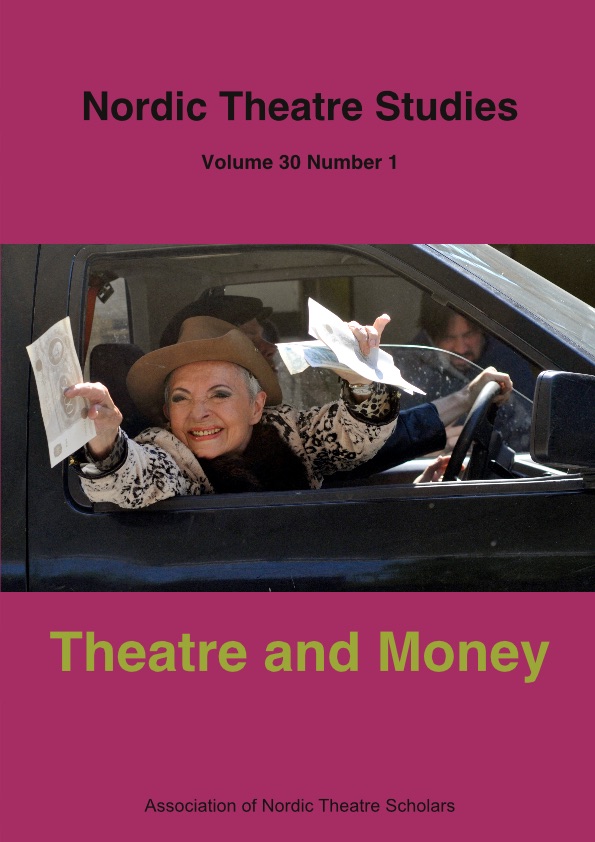Poor Theatre, Rich Theatre
Layers of Exchange in Two Adaptations of Ingmar Bergman and Paavo Haavikko
DOI:
https://doi.org/10.7146/nts.v30i1.106927Keywords:
Ingmar Bergman, dramaturgy, Paavo Haavikko, metaphor and metonymy, scenography, theatricalityAbstract
The article analyzes two Finnish theatre adaptations of Fanny och Alexander, by Ingmar Bergman, and Rauta-aika, by Paavo Haavikko, premiered in 2010 and 2011 respectively. The key question is, how the two works brought the filmic originals’ wealth of material to theatrically manageable proportions, and how the themes of poverty and prosperity were developed by their scenic machineries – a question of theatricality, but also, if you will, of a sort of theatrical exchange: “golden age” to exile or decline in the story-worlds, lavish film to theatrical constraint in production. The first two sections take a specifically economic perspective on the original TV projects and their central storylines; the two final sections address how these storylines were locally woven by the revolving stage and the revolving auditorium used in the theatre productions. On various levels, a playfully “monetary” distinction of metonymy and metaphor is suggested in which metonymic contiguity stands for contextual prosperity (as experience, community, immediacy), metaphoric substitution for relative deprivation (as distance, abstraction, exchange).
References
Bergman, Ingmar. 1982. Fanny and Alexander. Trans. Alan Blair. New York: Pantheon.
Bergman, Ingmar. 1994. Images: My Life in Film. Trans. Marianne Ruuth. New York: Arcade.
Fanny ja Alexander. Directed by Tiina Puumalainen. Actors: Pentti Helin, Kaisa Matti-la, Jaana Oravisto, Puntti Valtonen, Riku Suokas, Matti Pussinen-Eloranta, Tomi Salmela, Mari Turunen, Minna Hokkanen. Premiere 4 Nov 2010, Tampere Workers’ Theatre, Tampere. DVD recording 3 Nov 2010.
Grotowski, Jerzy. 2002 (1968). Towards a Poor Theatre. New York: Routledge.
Haavikko, Paavo. 1982. Rauta-aika. Helsinki: Otava.
Haavikko, Paavo. 1989. Kullervon tarina / Kullervo’s Story. Trans. Anselm Hollo. Helsinki: Art House.
Haavikko, Paavo. 1995. Prospero: Muistelmat vuosilta 1967–1995. Helsinki: Art House.
Holma, Seija. 2010. Fanny ja Alexander. Adaptation. Script dated 11 March 2014.
Holma, Seija. 2011. Rauta-aika. Adaptation. Script dated June 2011.
Hornborg, Alf. 2016. Global Magic: Technologies of Appropriation from Ancient Rome to Wall Street. New York: Palgrave Macmillan.
Hukka, Eija. 1994. “Mitä pitikään unohtaa…? Rauta-ajan ristiriitaisesta vastaanotosta” in Tekstin takaa: tutkimuksia suomalaisesta kirjallisuusjärjestelmästä. Eds. Pertti Kuittinen, Erkki Sevänen and Risto Turunen. 233–52. Joensuu: Joensuun yliopisto.
Ingmar Bergman Foundation. “Fanny and Alexander.”
http://www.ingmarbergman.se/en/production/fanny-and-alexander-0 (28 April 2017).
Jakobson, Roman. 1971 (1956). Fundamentals of Language. With Morris Halle. 2nd ed. The Hague: Mouton.
Kakutani, Michiko. 1983. “Ingmar Bergman: Summing Up a Life in Film.” The New York Times, 6 June 1983.
Kalin, Jesse. 2003. The Films of Ingmar Bergman. Cambridge: Cambridge University Press.
Laaksonen, Pekka. 1983. “Rauta-ajan kevät.” Suomalainen vuosikirja 1983, 104–12. Helsinki: Suomalaisen Kirjallisuuden Seura.
Laine, Kimmo & Hannu Salmi. 2009. “From Sampo to The Age of Iron: Cinematic Interpretations of the Kalevala.” Journal of Finnish Studies 13:2, 73–84.
Long, Robert Emmet. 1994. Ingmar Bergman: Film and Stage. New York: Abrams.
Paavolainen, Teemu. 2012. Theatre/Ecology/Cognition: Theorizing Performer-Object Interaction in Grotowski, Kantor, and Meyerhold. New York: Palgrave Macmillan.
Paavolainen, Teemu. 2015. “Meaning in the Weaving: Mapping and Texture as Figures of Spatiality and Eventness.” Nordic Theatre Studies 27:2, 10–21.
http://dx.doi.org/10.7146/nts.v27i2.24247
Paavolainen, Teemu. 2018. Theatricality and Performativity: Writings on Texture From Plato’s Cave to Urban Activism. Basingstoke: Palgrave Macmillan.
Partanen, Juha. 1982. “Keskustelua Rauta-ajasta.” Kulttuurivihkot 4, 40–1.
Pentikäinen, Johanna. 2004. Rautaa, unta ja kultaa: myytit ja myyttien käyttö Paavo Haavikon Kalevala-aiheisissa teoksissa. Helsinki: Suomalaisen Kirjallisuuden Seura.
Quart, Barbara & Leonard Quart. 1983. “Fanny and Alexander.” Review. Film Quarterly 37:1, 22–7.
Rauta-aika. Directed by Kari Heiskanen. Actors: Aimo Räsänen, Auvo Vihro, Anneli Sauli, Iikka Forss, Sanna Majanlahti, Marika Heiskanen, Samuli Muje, Janne Kallioniemi, Antti Mikkola, Annina Ärölä, Maiju Saarinen, Ville Majamaa. Premiere 17 June 2011, Pyynikki Summer Theatre, Tampere. DVD recording 6 Aug 2011, edited by Jarkko Laaksonen.
Sihvo, Hannes. 1980. Soutu Bysanttiin: Paavo Haavikon metodin ja maailmankuvan tarkastelua. Helsinki: Suomalaisen Kirjallisuuden Seura.
Sihvo, Hannes. 1984. “Paavo Haavikko: Renewer of the Kalevala Myth.” Trans. Philip Binham. World Literature Today 58:4, 545–7.
States, Bert O. 1985. Great Reckonings in Little Rooms: On the Phenomenology of Theater. Berkeley: University of California Press.
Steene, Birgitta. 2005. Ingmar Bergman: A Reference Guide. Amsterdam: Amsterdam University Press.
Strindberg, August. 1973 (1901). A Dream Play. Adapted by Ingmar Bergman. Trans. Michael Meyer. London: Secker & Warburg.
Tarkka, Pekka. 1984. “Haavikko, Money and History.” Trans. Aili and Austin Flint. World Literature Today 58:4, 534–8.
Törnqvist, Egil. 1995. Between Stage and Screen: Ingmar Bergman Directs. Amsterdam: Amsterdam University Press.
Downloads
Published
How to Cite
Issue
Section
License
The copyright belongs to the authors and Nordic Theatre Studies. Users can use, reuse and build upon the material published in the journal but only for non-commercial purposes. Users are allowed to link to the files, download the files, distribute the files on a local network (preferably by links), upload the files to local repositories if their institutions require them to do so, but not republish the files without proper agreements with the journal and the author.

